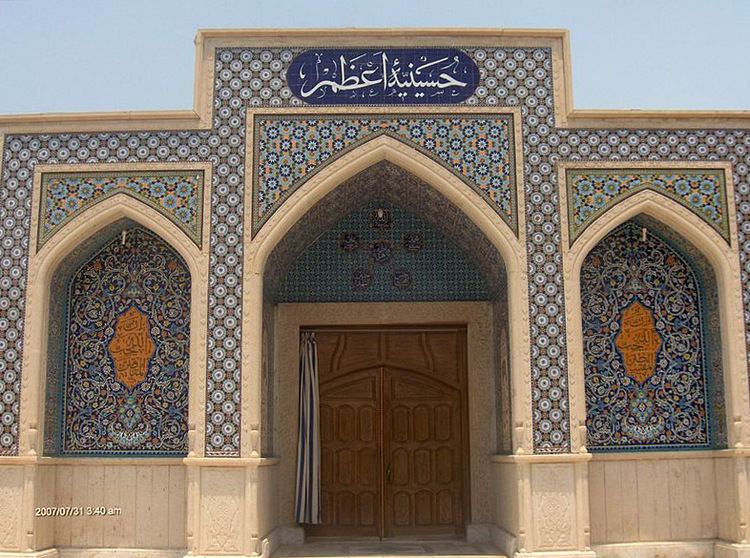Local time Tuesday 3:55 AM | County Dashtestan Time zone IRST (UTC+3:30) | |
 | ||
Weather 16°C, Wind E at 2 km/h, 55% Humidity | ||
Borazjan (Persian: برازجان; also Romanized as Borāzjān ; also known as Borazdjan and Borāzjūn) is a city in and the capital of Dashtestan County, Bushehr Province, Iran. At the 2006 census, its population was 124,291, in 20,300 families.
Contents
- Map of Borazjan Bushehr Province Iran
- Leopard killed here in borazjan
- History
- Town description
- Economy
- References
Map of Borazjan, Bushehr Province, Iran
Leopard killed here in borazjan
History
The city is very old. The ruins around the city are over three hundred years old. A citadel that was constructed 250 years ago and served as a caravansarai for decades has been transformed into a prison in the last 70 years. Many jewels and treasures have been discovered around the town. In ancient times, the town was actually by the Persian Gulf. However receding water has pushed the coastline 100 km south to where the city of Bushehr is today. This has left vast amounts of salt covered flats from Borazjan to Bushehr. The land is sparkling white. The salt crystals can be used to extract many minerals such as brine and sodium however such extraction does not exist.
The surrounding landscape was greener in the past however over grazing and drier climate has killed off most of the vegetation. Many wild animals such as deer, boars and cayotes lived in the area, but they have since gone extinct.
Town description
Borazjan is the capital city of Dashtestan county, and is the largest city of the province. Approximately 70 km north of Bushehr, it was built based on the waters which flow from Giskan mountains into Dalaki river. Borazjan grew rapidly over the last two decades. The population of the town was 10,000 in 1980, 40,000 in 1990, 75,000 in 2000, and 124,291 in 2006. The two reasons for the growth have been an ever increasing migration of villagers and nomads from the surrounding area to the city, and an explosive birth rate of 4%.
A very large and modern hospital serves the city and far away communities surrounding the city. The hospital has a helipad and a helicopter. This helicopter is not used for the welfare of the general population; it only takes wealthy paying passengers.
The city has one large fire department. It has several engines on standby for the city and beyond however it is rarely used. If the engines leave the station it quickly becomes the talk of town as to what happened.
The city has no airport. There has consistently been the talk of creating a small airport to serve the town. The nearest airport is in Bushehr about 100 km away. Research in 1992 showed that for every 100 passengers flying out of Bushehr for Tehran 35 were from Borazjan. This is not enough to create an airport but proponents attest that opening one up would encourage the growth of the town.
The main street of Borazjan is called Bimarestan Street. Bimarestan translates to Hospital in English. The hospital is located on this street. Many young people drive up and down this street in motor cycles in their free time.
The city also has a very large cemetery. The cemetery again serves the town and all the surrounding areas. The cemetery has no cremation facilities as this is not practiced in Iran. The cemetery is very beautiful and has many trees. On Fridays it is very busy with mourners and visitors.
Borazjan used to be home to a large Jewish population and locals believe that some Israeli officials are originally from this city.
The climate is dry and hot, and main products are dates, flour and tobacco.
Economy
The main economy of the city is food processing from the nearby fields. The largest silo in all of southern Iran is in Borazjan. It was built with Russian aid and completed in 1971. It houses grain shipped there from the surrounding farms. The cultivation of dates and the processing and packaging of dates is a very important industry. About half of the dates are shipped north to consumers in the rest of the country and half are shipped to Bushehr to be exported to other countries.
The nearby farms are almost all privately owned. They average only several acres in size each. A handful of people own very large pieces of land and use very modern machinery to maximize its potential. Farm workers and day labourers are a common sight in these areas.
Products grown around the city in order of popularity (not monetary value per se) are wheat, dates, sesame seeds, watermelons, and tomatoes.
There are two major flouring mill factories in Borazjan: Al-Zahra and Borazjan flouring mills.
Other industry near or around the town consists of furniture making, metal working, small scale manufacturing, and textiles.
